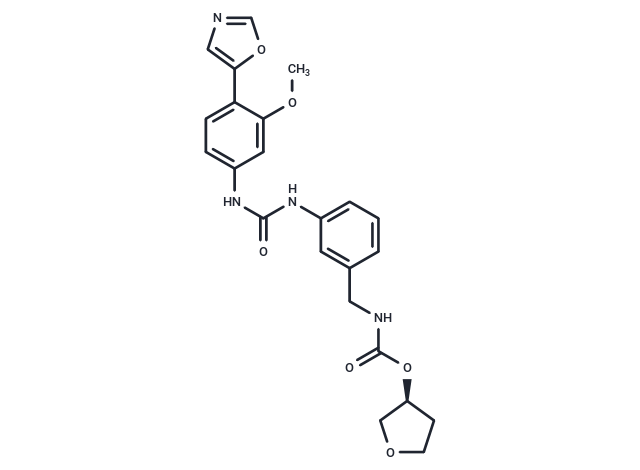Shopping Cart
- Remove All
 Your shopping cart is currently empty
Your shopping cart is currently empty

Merimepodib (VX-497) is a novel, noncompetitive inhibitor of inosine monophosphate dehydrogenase (IMPDH).

| Pack Size | Price | Availability | Quantity |
|---|---|---|---|
| 1 mg | $39 | In Stock | |
| 5 mg | $91 | In Stock | |
| 10 mg | $163 | In Stock | |
| 25 mg | $297 | In Stock | |
| 50 mg | $538 | In Stock | |
| 100 mg | $777 | In Stock | |
| 1 mL x 10 mM (in DMSO) | $90 | In Stock |
| Description | Merimepodib (VX-497) is a novel, noncompetitive inhibitor of inosine monophosphate dehydrogenase (IMPDH). |
| In vitro | Merimepodib has antiproliferative effect on lymphoid and keratinocyte cells. Merimepodib (MW 452.5) is orally bioavailable and inhibits the proliferation of primary human, mouse, rat, and dog lymphocytes at concentrations of approximately 100 nM. The antiproliferative effect of Merimepodib in cells is reversed within 48 h of its removal[1]. Merimepodib has intermediate antiviral activity against a second group of viruses, which includes HSV-1, parainfluenza-3 virus, BVDV, VEEV, and dengue virus, with IC50s ranging from 6 to 19 μM. Merimepodib is 100-fold more potent, with an IC50 of 380 nM and a corresponding CC50 of 5.2 μM, for a therapeutic index of 14. The antiviral activity of Merimepodib in HepG2.2.2.15 cells is reversed threefold by the addition of guanosine[2]. |
| In vivo | Oral administration of Merimepodib inhibits the primary IgM antibody response in a dose-dependent manner, with an ED50 value of appr 30-35 mg/kg in mice. Single daily dosing of Merimepodib is shown to be as effective as twice-daily dosing in this model of immune activation[1]. GVHD developed in the vehicle-treated allografted F1 mice and treatment with Merimepodib improved all manifestations of the disease significantly. The 2.9-fold increase in spleen weight in allografted animals is reduced to a 1.6-fold increase in the Merimepodib-treated mice. Serum IFN-gamma levels are increased 54-fold in the vehicle group while there is a 7.4-fold increase in Merimepodib-treated animals[3]. |
| Cell Research | The murine fibroblast L929 cell line is cultured in Eagle minimal essential medium supplemented with 10% fetal bovine serum, nonessential amino acids, 50 U of penicillin per mL, 50 μg of streptomycin per mL, and 2 mM?l-glutamine. EMCV is infected at 500 PFU/107?L929 cells. Cells are left untreated or are treated with different concentrations of murine IFN-α alone, VX-497 alone, or combinations thereof. |
| Alias | VX-497, VI-21497 |
| Molecular Weight | 452.46 |
| Formula | C23H24N4O6 |
| Cas No. | 198821-22-6 |
| Smiles | COc1cc(NC(=O)Nc2cccc(CNC(=O)O[C@H]3CCOC3)c2)ccc1-c1cnco1 |
| Relative Density. | 1.36 g/cm3 (Predicted) |
| Storage | Powder: -20°C for 3 years | In solvent: -80°C for 1 year | Shipping with blue ice. | ||||||||||||||||||||||||||||||
| Solubility Information | DMSO: 31 mg/mL (68.51 mM), Sonication is recommended. | ||||||||||||||||||||||||||||||
Solution Preparation Table | |||||||||||||||||||||||||||||||
DMSO
| |||||||||||||||||||||||||||||||

Copyright © 2015-2025 TargetMol Chemicals Inc. All Rights Reserved.